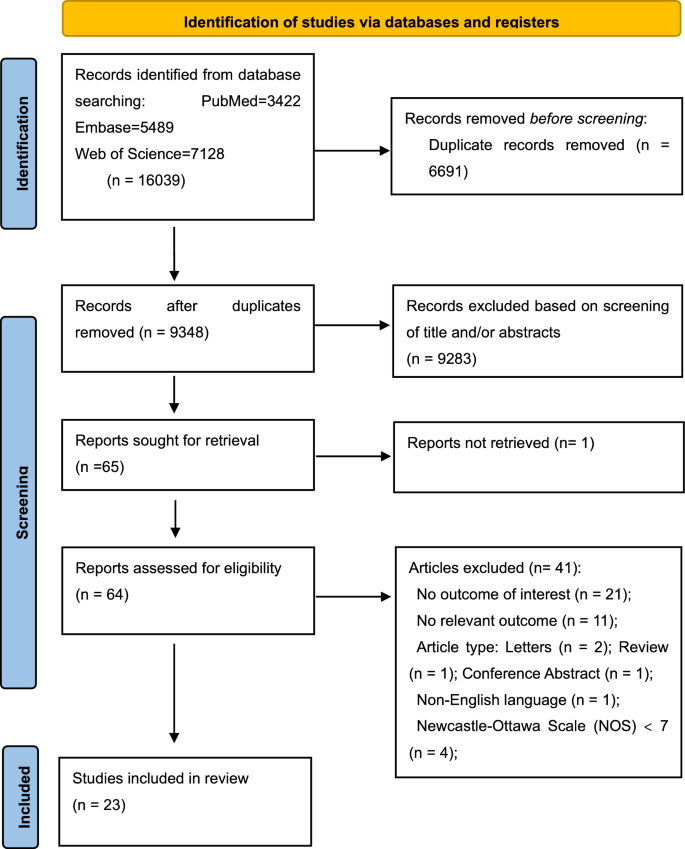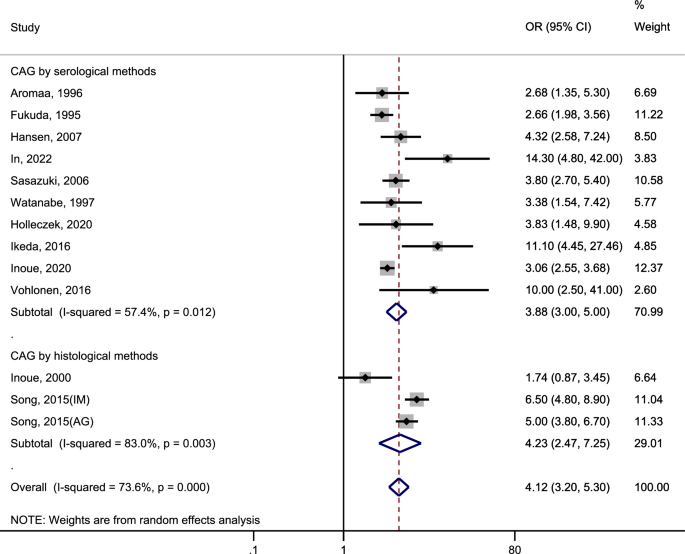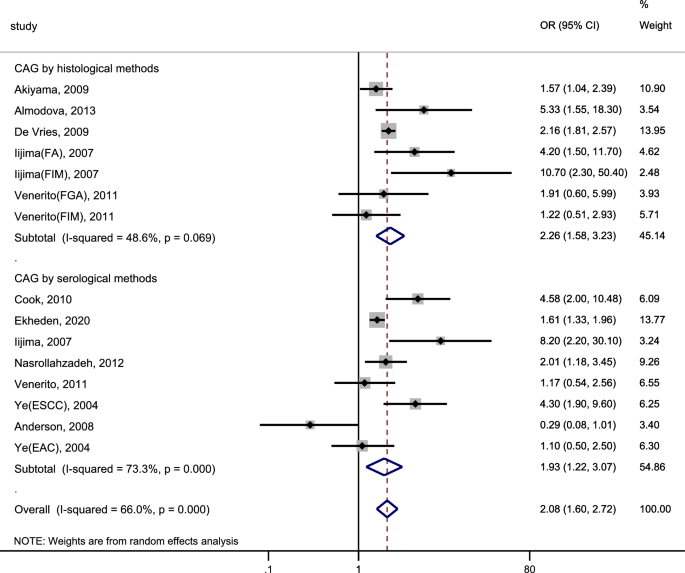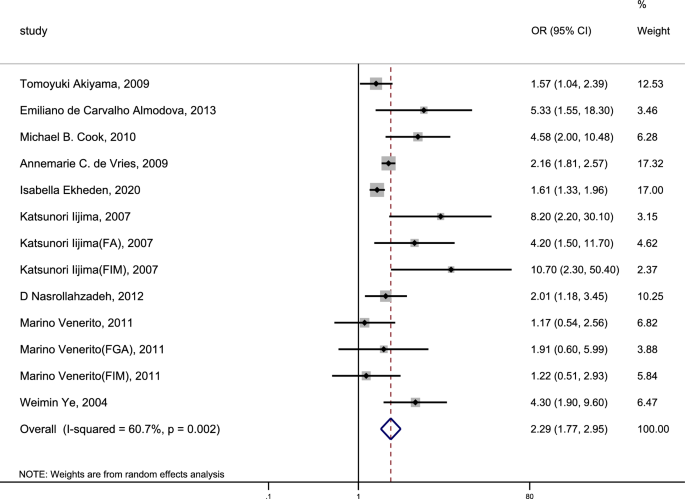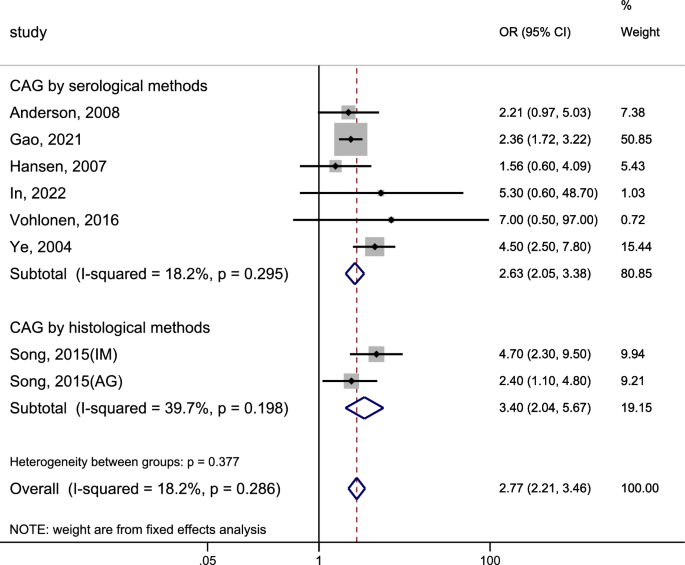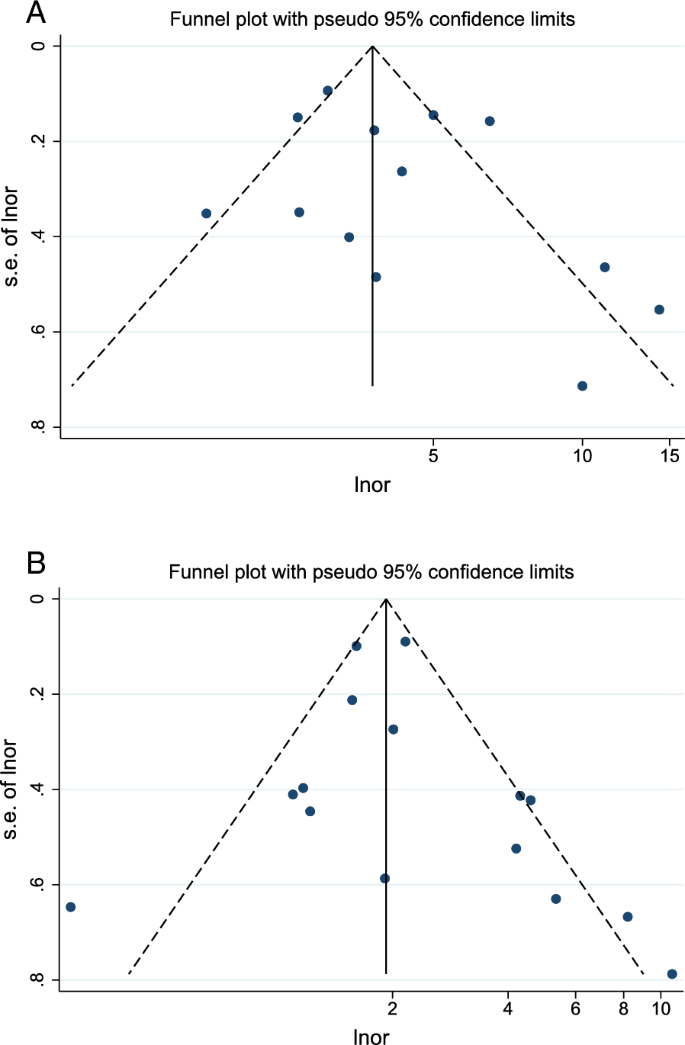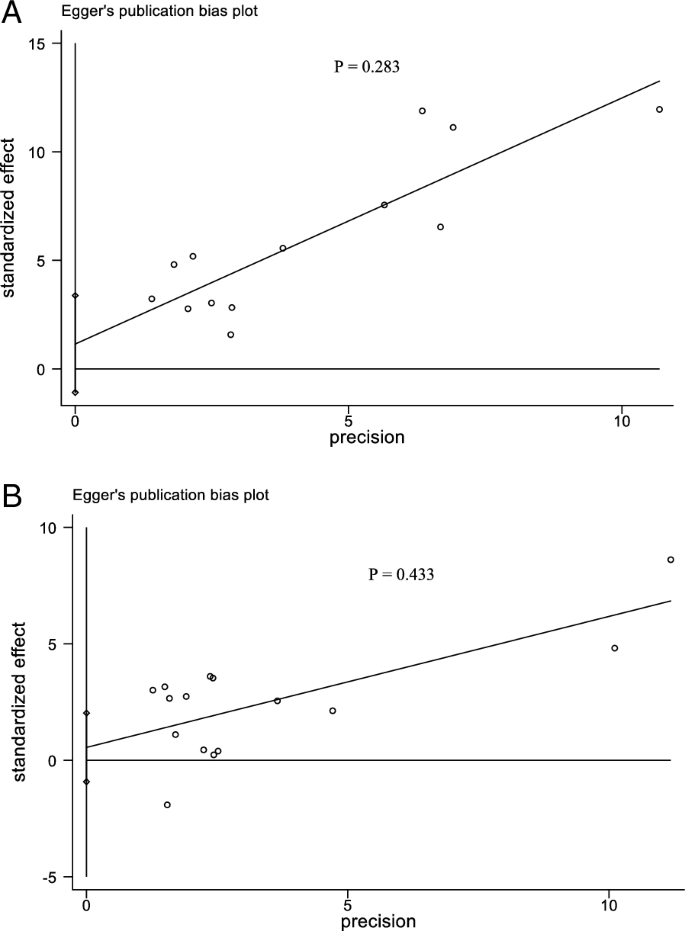- Review
- Open access
- Published:
Chronic atrophic gastritis and risk of incident upper gastrointestinal cancers: a systematic review and meta-analysis
Journal of Translational Medicine volume 22, Article number: 429 (2024)
Abstract
Background
Previous literature has explored the relationship between chronic atrophic gastritis (CAG) and isolated cancers within the upper gastrointestinal cancers; However, an integrative synthesis across the totality of upper gastrointestinal cancers was conspicuously absent. The research objective was to assess the relationship between CAG and the risk of incident upper gastrointestinal cancers, specifically including gastric cancer, oesophageal cancer, and oesophagogastric junction cancer.
Methods
Rigorous systematic searches were conducted across three major databases, namely PubMed, Embase and Web of Science, encompassing the timeline from database inception until August 10, 2023. We extracted the necessary odds ratio (OR) and their corresponding 95% confidence interval (CI) for subsequent meta-analysis. Statistical analyses were conducted using Stata 17.0 software.
Results
This meta-analysis included a total of 23 articles encompassing 5858 patients diagnosed with upper gastrointestinal cancers. CAG resulted in a statistically significant 4.12-fold elevated risk of incident gastric cancer (OR = 4.12, 95% CI 3.20–5.30). Likewise, CAG was linked to a 2.08-fold increased risk of incident oesophageal cancer (OR = 2.08, 95%CI 1.60–2.72). Intriguingly, a specific correlation was found between CAG and the risk of incident oesophageal squamous cell carcinoma (OR = 2.29, 95%CI 1.77–2.95), while no significant association was detected for oesophageal adenocarcinoma (OR = 0.62, 95%CI 0.17–2.26). Moreover, CAG was correlated with a 2.77-fold heightened risk of oesophagogastric junction cancer (OR = 2.77, 95%CI 2.21–3.46). Notably, for the same type of upper gastrointestinal cancer, it was observed that diagnosing CAG through histological methods was linked to a 33–77% higher risk of developing cancer compared to diagnosing CAG through serological methods.
Conclusion
This meta-analysis indicated a two- to fourfold increased risk of gastric cancer, oesophageal cancer, and oesophagogastric junction cancer in patients with CAG. Importantly, for the same upper gastrointestinal cancer, the risk of incident cancer was higher when CAG was diagnosed histologically compared to serological diagnosis. Further rigorous study designs are required to explore the impact of CAG diagnosed through both diagnostic methods on the risk of upper gastrointestinal cancers.
Introduction
Within the global healthcare arena, cancer plays a dual role, being both a disease of significant global interest and a principal factor in clinical mortality. It is characterized by a protracted disease course, a predisposition for deterioration, low survival rates, and a significant economic burden. With the ageing of the population and an increase in cancer risk factors, the incidence and mortality of cancer have also risen.
Upper gastrointestinal cancers, comprising gastric cancer (GC), oesophagogastric junction cancer (OJC), and oesophageal cancer (OC); Oesophageal cancer is mainly classified into two subtypes: oesophageal adenocarcinoma (OAC) and oesophageal squamous cell carcinoma (OSCC). In 2019, there were approximately 23.6 million new cancer cases reported worldwide, with upper gastrointestinal cancers representing about 7.6% of these cases; Meanwhile, the worldwide cancer-related mortality rate reached an estimated 10.0 million, and upper gastrointestinal cancers were responsible for roughly 14.6% of these deaths [1]. The etiopathogenesis and progression of upper gastrointestinal cancers are closely linked to numerous factors, including diet, lifestyle, and others [2, 3]. Notably, Chronic atrophic gastritis (CAG) has captured the attention of researchers as a potential risk factor. This association is consistent with the involvement of chronic inflammation in cancer development [4, 5].
CAG is a chronic inflammatory disease characterized by the reduction or loss of gastric mucosal glands, with or without metaplasia of the intestinal epithelium or pyloric glands. A primary etiological factor in the development of this disease is the infection of H. pylori [6,7,8]. Upon infection, the gastric mucosa undergoes an intense inflammatory response, resulting in tissue damage and an increased risk of cancer [9]. Subsequently, some researchers initiated studies of the associations between CAG and upper gastrointestinal cancers. Over the last 15 years, the majority of studies have primarily centred around meta-analyses examining the relationship between CAG and GC [10, 11]. However, there has been relatively limited research concerning the relationship between CAG and OC or OJC. Notably, it was not until 2010 that a meta-analysis was published, reporting on the risk of gastric atrophy in the development of OAC and OSCC [12]. At present, no exhaustive meta-analysis offers a comprehensive assessment of the risk of upper gastrointestinal cancers in relation to CAG. Meanwhile, with advances in medical science and technology, the primary diagnostic modality for CAG has shifted towards histological methods, whereas previous studies mainly used serologic diagnostic modalities. However, Whether the risk relationship between CAG diagnosed using these two diagnostic methods and upper gastrointestinal cancers is consistent remains unclear and has not been clearly reported.
Consequently, we conducted this systematic review and meta-analysis to comprehensively and accurately assess the magnitude and nature of the relationship between CAG and the incidence risk of upper gastrointestinal cancers. Furthermore, we aimed to report the extent of risk associated with the diagnosis of CAG through histological and serological methods for the development of upper gastrointestinal cancers.
Materials and methods
This study was conducted in accordance with the recommendations of the Preferred Reporting Items for Systematic Reviews and Meta-Analyses (PRISMA) [13] and was registered with the PROSPERO (CRD42023455940).
Search strategy
We systematically searched databases (PubMed, Embase, Web of Science) using a combination of search terms and free phrases to assess the risk association between CAG and upper gastrointestinal cancers. The search included articles published from the creation of the database through August 10, 2023. The search strategies used for each database are displayed in Additional file 1: File 1 Search strategy.
Inclusion and exclusion criteria
The inclusion criteria were as follows: (1) Case–control studies, nested case–control studies, or cohort studies; (2) To investigate the risk relationship between CAG and upper gastrointestinal cancers; (3) The diagnosis of CAG is based on endoscopic histology or serological methods. (4) The study involved human participants, with no restrictions on race or gender, and all individuals were aged 18 years or older. (5) The main outcome was the incidence risk of upper gastrointestinal cancers, which was measured using odds ratio (OR).
The exclusion criteria were as follows: (1) Case reports, reviews, commentaries, animal and cell studies, as well as cross-sectional research; (2) Duplicate publications; (3) Literature with missing research data and inability to extract the required data; (4) Non-English literature; (5) Newcastle–Ottawa Scale score (NOS) < 7.
Data extraction and quality assessment
According to the inclusion and exclusion criteria, two researchers (JQL and XY) independently screened titles and abstracts that met the requirements. Subsequently, they obtained and read the full texts, selecting articles that met the specified criteria. According to the data extraction guidelines for systematic reviews and meta-analyses [14], two researchers independently extracted the following information: study design, study’s author and year of publication, country, sample size, outcomes, study period, sex, diagnosis of CAG, assessment of cancer, adjustment for covariates, participant source and NOS score.
If a study did not clearly give a standard definition of gastric atrophy, we defined it as atrophic gastritis based on histological evidence of gastric mucosal atrophy and intestinal metaplasia. This was based on an expert review of atrophic gastritis updated by the American Gastrointestinal Association [15]. Hence, when independently assessing the risks associated with gastric mucosal atrophy and intestinal metaplasia in the literature, we regarded them as separate studies. Similarly, when conducting separate risk assessments for histology and serology, we also treated them as separate studies. If the literature independently assessed the risks of non-cardia cancer and cardia cancer, we extracted relevant data on non-cardia cancer for the study of gastric cancer incidence risk. In accordance with the classification of oesophagogastric junction adenocarcinoma [16], we included cardia cancer-related data in the study of oesophagogastric junction cancer incidence risk.
We undertook a qualitative evaluation of the included literature utilizing the Newcastle–Ottawa Scale (NOS). This assessment was carried out independently by two researchers (JQL and JLP). The NOS scale comprises three aspects of evaluation, with scores ranging from 0 to 9. In this study, the quality assessment scores for all screened literature were 7 or higher. Therefore, the literature screened in this study was considered to be of high quality [17].
Any disagreements encountered during the processes of data extraction and quality assessment were addressed through discussions with the senior author (LJX).
Statistical methods
The meta-analysis was conducted by comparing the risk of upper gastrointestinal cancers between patients with and without CAG. We extracted OR, hazard ratio (HR), and relative risk (RR) from the eligible literature. Given the relatively low risk of upper gastrointestinal cancers, during the data analysis, the extracted HR and RR were approximated to be equal to the OR [18]. We used the OR and its corresponding 95% confidence interval (CI) for statistical analysis.
The statistical analyses were performed using Stata 17.0 software. To assess heterogeneity, we used the Q-test and the I2 value. When I2 > 50% or P < 0.1, we considered significant heterogeneity among the studies, allowing for the adoption of a random-effects model. Otherwise, a fixed-effects model was used; Additionally, in order to explore the sources of heterogeneity, we conducted subgroup analyses based on the diagnosis of CAG, study type, participant source, region, year of publication, and NOS score. Sensitivity analysis was conducted to evaluate the robustness and reliability of the results. Funnel plots and Egger's test were used to analyze publication bias.
Results
Search results
Initially, we retrieved a total of 16,039 articles, which included 3422 from PubMed, 5489 from Embase, and 7128 from Web of Science. Among these, 6691 duplicates were identified and subsequently excluded, followed by the exclusion of 9,283 irrelevant articles after a screening of titles and abstracts. We conducted a comprehensive search of the full text of 65 articles, excluding one article that was unavailable. Following a detailed examination of the full texts, we excluded 41 studies for various reasons, including 21 studies lacking relevant outcomes, 11 studies with unrelated outcomes, 2 studies were letters, 1 study was review, 1 study in a non-English language, 1 study was conference abstract, and 4 studies with a NOS < 7.
Finally, a total of 23 articles involving 5858 patients diagnosed with upper gastrointestinal cancers were incorporated into this study. The flowchart of the study screening is shown in Fig. 1 (Page 30).
Characteristics of included studies
We have identified 23 articles, containing 36 studies, to assess the relationship between CAG and the risk of incident upper gastrointestinal cancers [19,20,21,22,23,24,25,26,27,28,29,30,31,32,33,34,35,36,37,38,39,40,41]. Among these, 13 studies analyzed gastric cancer, 15 studies examined oesophageal cancer, and 8 studies explored oesophagogastric junction cancer. CAG was diagnosed using endoscopic histological methods (found in a total of 7 articles) and serological methods (found in a total of 18 articles), with 2 articles conducting research on both of these diagnostic approaches.
In the included literature, there were 10 case–control studies, 6 nested case–control studies, and 7 cohort studies. Detailed characteristics of these incorporated studies can be found in Table 1 (Pages 31–35). These studies were published between 1995 to 2023 and collectively involved 5858 patients diagnosed with upper gastrointestinal cancers, with two articles exclusively focused on male populations. For the source of study participants, there were 5 articles based on hospital-based research, 17 articles based on population-based research, and 1 article based on a combination of population and clinic-based research. In terms of the regional distribution of the study, 10 articles were performed in Europe, 11 articles in Asia (including 8 articles in Japan), and 2 articles in the Americas. According to the NOS scale score, 6 studies received a score of 9, 18 studies achieved a score of 8, and 12 studies were rated with a score of 7.
Risk of gastric cancer
Thirteen studies were included to assess the relationship between CAG and the incidence of GC. The heterogeneity test (I2 = 73.6%, P < 0.1) indicated significant heterogeneity in this study. The pooled results were shown in Fig. 2 (Page 39): CAG was associated with a 4.12-fold increase in the risk of GC (pooled random effect OR = 4.12, 95%CI 3.20 ~ 5.30); The risk of incident GC, when diagnosed through histological methods for CAG, was higher (OR = 4.23, 95% CI 2.47–7.25) compared to the risk associated with diagnosing CAG through serological methods (OR = 3.88, 95% CI 3.00–5.00).
Significant heterogeneity was observed in this study. In order to delve the origins of heterogeneity, we conducted subgroup analyses based on the diagnosis method of CAG, study type, participant source, region, year of publication, and NOS score. The relevant results are presented in Table 2 (Page 36). There was no significant heterogeneity in nested case–control studies, European studies, or studies published between 1995 and 2010. However, significant heterogeneity was detected in all other subgroup analyses. In all subgroups, patients with CAG had a significantly increased risk of incident GC. Particularly, studies conducted in the United States showed the highest relative risk of GC incidence among patients with CAG (OR = 14.30, 95% CI 4.83–42.30). This study was both a case–control and a hospital-based study, and it showed that patients with CAG had a relatively low risk of developing GC (OR = 2.66, 95% CI 1.98–3.57). In other subgroup analyses, the risk of incident GC was very similar to the overall pooled risk.
Risk of oesophageal cancer
We included 15 studies that explored the association between CAG and the incidence of OC. The heterogeneity analysis indicated significant heterogeneity within this research (I2 = 66.0%, P < 0.1). The pooled results were shown in Fig. 3 (Page 39).: CAG was associated with a 2.08-fold increase in the risk of incident OC (pooled random-effect OR = 2.08, 95% CI 1.60–2.72). The risk of incident OC was markedly higher with the diagnosis of CAG through histologic methods (OR = 2.26, 95% CI 1.58–3.23) compared to the risk associated with diagnosing CAG through serologic methods (OR = 1.93, 95%CI 1.22–3.07). Meanwhile, we assessed the relationship between CAG and the risk of incident OSCC and OAC (Figs. 4, 5; Page 40). Our findings indicated that CAG was linked to a 2.29-fold increase in the risk of incident OSCC (pooled random-effects OR = 2.29, 95% CI 1.77–2.95, I2 = 60.7%, P = 0.002). Nevertheless, there was no significant association between CAG and the risk of incident OAC (pooled random effect OR = 0.62, 95% CI 0.17–2.26, I2 = 67.0%, P = 0.082).
In order to explore the sources of heterogeneity, we performed subgroup analyses based on the diagnosis method of CAG, study type, participant source, region, year of publication, and NOS score. As shown in Table 3 (Pages 37, 38), there was no significant heterogeneity in studies where CAG diagnosis was based on histologic methods and those published from 2011 to 2023. However, significant heterogeneity was observed in all other subgroup analyses. Additionally, studies with an NOS score < 8 did not reveal a significant association between CAG and the risk of OC, whereas all other subgroup analyses indicated a significant correlation. In the nested case–control study (OR = 4.58, 95%CI 2.00–10.48) and the study conducted in the Americas (OR 5.33, 95%CL 1.55–18.30), patients with CAG had a relatively higher risk of incident OC. In studies published from 2011 to 2023, the risk of OC in patients with CAG was relatively lower (OR = 1.66, 95%CI 1.35–2.04). In all other subgroup analyses, the risk of incident cancer was similar to the overall pooled risk.
Risk of oesophagogastric junction cancer
We included 8 studies to examine the association between CAG and the risk of incident OJC. The heterogeneity test indicated a low level of heterogeneity in this study (I2 = 18.2%, P = 0.286 > 0.1). The pooled results were displayed in Fig. 6 (Page 40): CAG was associated with a 2.77-fold increased risk of OJC (pooled fixed effect OR = 2.77, 95% CI 2.21–3.46). The risk of OJC was significantly higher when CAG was diagnosed through histological methods (OR = 3.40, 95%CI 2.04–5.67) compared to serological methods (OR = 2.63, 95%CI 2.05–3.38), and neither of these groups of studies displayed significant heterogeneity.
Sensitivity analyses and publication bias
For GC, OC and OJC, we performed sensitivity analyses using a study-by-study exclusion approach, and our findings demonstrated the stability and reliability of the pooled results (Additional file 2: Fig. S1a–c). To evaluate publication bias in GC and OC, we used funnel plots and Egger's tests. Visual inspection of the funnel plots (Fig. 7) (Page 41) showed that the distributions were generally symmetrical, indicating that there was no significant publication bias. The results of the Egger's test (Fig. 8) (Pages 41, 42) indicated that, in the analysis of GC (P = 0.283) and OC (P = 0.433), no significant publication bias was observed in the studies.
Discussion
In this meta-analysis, we included a total of 23 studies involving 5858 patients diagnosed with upper gastrointestinal cancers. Our objective was to analyze the connection between CAG and the incidence of upper gastrointestinal cancers. The results clearly pointed to a significant 4.12-fold elevation in the risk of GC, a 2.77-fold increase in the risk of OJC, and a 2.08-fold rise in the risk of OC among patients with CAG. Furthermore, our findings indicated a 2.29-fold increased risk of OSCC in CAG patients. However, no significant association was detected with the risk of OAC. Intriguingly, when considering the same upper gastrointestinal cancer, the risk of developing cancer was higher with CAG diagnosed through histologic methods rather than serologic methods.
This study represents the first comprehensive assessment of the association between CAG and the incidence of upper gastrointestinal cancers. Our findings reveal a substantial increase in the risk of upper gastrointestinal cancers linked to CAG, which is both consistent and inconsistent with previously published meta-analyses in different regards. Previously, gastric atrophy has been correlated with a 2.89-fold elevated risk of Cardia Cancer when diagnosed through serologic methods [12]. In contrast, our current study explores the risk of CAG and the incidence of OJC, employing both histologic and serologic diagnostic methods. Additionally, Gastric Atrophy has previously exhibited associations with the risk of OSCC and OAC, with a 1.94-fold heightened risk of OSCC incidence but a reduced risk of OAC development [12]. In this study, we have not only reported the link between CAG and an elevated risk for developing OSCC and OAC but have also indicated its relevance to the risk of developing EC. Worth noting is that patients with Intestinal Metaplasia (IM) have been previously reported to exhibit a significant 3.58-fold increase in the risk of GC, particularly when IM develops in the gastric body or presents as incomplete IM [42]; A systematic review and meta-analysis conducted by Sui [43] indicated that there was a significant 2.91-fold increase in the risk of GC associated with gastric atrophy; These results correspond with the trends observed in our own study. Furthermore, Sui's study further reported that the risk of developing GC was higher with CAG diagnosed through serum pepsinogen levels rather than endoscopy [43]. Interestingly, this result contradicts the findings of our study.
We hypothesize several potential mechanisms underlying the association between CAG and upper gastrointestinal cancers. First and foremost, CAG is predominantly attributed to H. pylori infection. H. pylori can generate a multitude of virulence factors that target gastric mucosal tissues, disrupting intracellular signalling pathways and lowering the threshold for tumour transformation. Notably, the primary virulence factors of H. pylori include cytotoxin-associated gene A (CagA) and its pathogenicity island (Cag PAI), as well as vacuolating cytotoxin A (VacA). The Wnt signalling pathway, known for its role in cancer development, is implicated in GC through the upregulation of Wnt10A in gastric mucosa-associated cells, further activating the Wnt-β-catenin-Tcf signalling pathway, significantly contributing to GC development [44]. Similarly, the upregulation of Wnt10A may also be a factor in OC development [45], as subsequent studies have indicated its enhancement of invasion and migration in OSCC [46]. Secondly, CAG induced by H. pylori infection is characterized by reduced or complete abstention of gastric acid secretion, leading to the creation of a hypochlorhydric microenvironment. Such a microenvironment fosters the proliferation of oncogenic microorganisms within the stomach and augments the production of N-nitroso compounds, which significantly increases the risk of GC and OSCC [47,48,49]. The incidence risk of OAC is positively linked to gastroesophageal reflux symptoms [50] but negatively associated with H. pylori infection [41]. Consequently, CAG triggered by H. pylori infection would seem to either reduce the occurrence of OAC or have no discernible impact. The risk of OJC may exhibit two potential scenarios: some cases, similar to OAC, OJC could have a negative correlation or no association with CAG. meanwhile, others, resembling GC, may show a positive correlation with CAG. Lastly, chronic inflammation is one of the potential mechanisms contributing to cancer development, and this applies equally to upper gastrointestinal cancers. When tissue damage occurs, inflammatory cells gather and release inflammatory cytokines, thereby promoting the generation of reactive oxygen species (ROS). These ROS induce cellular proliferation, causing oxidative damage to DNA and, in turn, amplifying the risk of cancer development [4]. CAG remains in a chronic inflammatory state, particularly following H. pylori infection, which triggers the upregulation of multiple pro-inflammatory factors, including interleukin-8 (IL-8), nuclear factor-κB (NF-κB), tumour necrosis factor-α (TNF-α), and interleukin-6 (IL-6) and others. The upregulation of IL-8 and activation of NF-κB in gastric epithelial cells play pivotal roles in the mechanisms underlying chronic inflammation and the development of GC [51]. Additionally, NF-κB is closely associated with metastasis, inflammation, and poor prognosis in OC patients [52].
This meta-analysis reveals a certain degree of heterogeneity. To ensure the robustness of our findings, we conducted a sensitivity analysis, which confirmed the stability of the pooled results. In our assessment of GC and OC studies, both funnel plots and Egger's tests were employed, and the results consistently showed no clear evidence of publication bias.
In the subgroup analyses, notable findings emerged. In the GC study, all subgroup analyses consistently indicated a significant increase in GC risk among patients with CAG. It is worth highlighting that the studies conducted in the United States (US) reported the highest incidence of GC, even though GC is relatively uncommon in the US. This discovery emphasizes the potential relevance of serum pepsin as a predictive marker for GC in the US [32]. Among Asian research, Japan remains the sole contributor to relevant studies, emphasizing the necessity for broader participation from other Asian regions in future observational research. Notably, there was a study that served as both a case–control study and hospital-based research, revealing a comparatively lower risk level, possibly associated with the control group's population selection process. In the field of OC research, studies with NOS scores below 8 did not reveal any significant risk association. Nevertheless, all other subgroup analyses consistently pointed to a marked increase in OC incidence risk associated with CAG. Studies conducted in Latin America indicated the highest risk of OC, whereas research published between 2011 and 2023 showed a comparatively lower OC risk. Hospital-based studies showed a comparatively higher OC risk than population-based studies, possibly due to the inclusion of more severe cases from hospital settings.
Another crucial aspect of our study is the exploration of the association between CAG diagnosed through two different diagnostic methods and the risk of upper gastrointestinal cancers. In studies assessing GC risk in relation to CAG, histological confirmation of CAG was linked to a 35% increased risk of GC compared to serological diagnosis. Similarly, regarding the relationship between CAG and OC risk, histologic diagnosis of CAG was connected to a 33% higher risk of OC compared to serologic diagnosis. Moreover, in the investigation of the risk of OJC associated with CAG, histological confirmation of CAG was associated with a 77% elevated risk of OJC compared to serological diagnosis. In general, for GC, OC and OJC, the risk of cancer development was linked to a 33%-77% higher when CAG is diagnosed histologically compared to serologically. It's important to note that the guidelines for managing precancerous gastric epithelial lesions and other lesions recommend serum pepsinogen level as the best noninvasive test for detecting atrophic gastritis. However, in cases of low serum pepsinogen levels, reliance on gastroscopy is necessary [53]. The accuracy of endoscopic biopsy results can be influenced by a range of factors, including the quality of biopsy samples, specimen handling, and the expertise of pathologists [54]. Furthermore, the use of different analytical methods and threshold values with serum pepsinogen diagnosis can result in varying levels of specificity and sensitivity [55]. Therefore, further research and investigation are essential to comprehensively assess the risk associated with CAG diagnosis for upper gastrointestinal cancers using these two methods.
Our meta-analysis has also additional important strengths. As previously mentioned, our study aims to provide the most comprehensive evaluation of the connection between CAG and the risk of upper gastrointestinal cancers to date. We have included data from Asia, Europe, and the Americas, ensuring that the selected studies adhere to a high standard of quality.
However, there are certain limitations to our study. Firstly, the pooled results are constrained by the scarcity of studies focusing on the association between CAG and the risk of incident OAC. Future large-scale observational studies are imperative to delve deeper into the relationship between CAG and the incidence of OAC. Furthermore, the studies we have incorporated into our analysis display differences in adjusted factors and involve differing study designs, potentially introducing additional bias into the pooled findings. The data in our study was primarily sourced from medical records and cancer registries, which might introduce a degree of selection bias into the dataset. Finally, the primary diagnostic modalities for CAG include endoscopic histology and serum pepsinogen levels. While these two methods are widely used in current medical practice, they still exhibit certain limitations. The former can be influenced by factors such as the endoscopist's skill, specimen handling protocols, and diagnostic interpretation by the pathologist, whereas the results of the latter may fluctuate based on specimen analysis techniques and the selection of critical values.
Conclusion
This meta-analysis showed a two- to fourfold increased risk of GC, EC and EJC in patients with CAG. Importantly, for the same upper gastrointestinal cancer, the risk of incident cancer was higher when CAG was diagnosed through histological methods compared to serological methods. Further rigorous study designs are required to explore the impact of CAG diagnosed through both diagnostic methods on the risk of upper gastrointestinal cancers.
Availability of data and materials
All data generated or analyzed during this study are included in this published article [and its Additional files].
Abbreviations
- CAG:
-
Chronic atrophic gastritis
- OR:
-
Odds ratio
- CI:
-
Confidence interval
- GC:
-
Gastric cancer
- OJC:
-
Oesophagogastric junction cancer
- OC:
-
Oesophageal cancer
- OAC:
-
Oesophageal adenocarcinoma
- OSCC:
-
Oesophageal squamous cell carcinoma
- PRISMA:
-
Preferred Reporting Items for Systematic Reviews and Meta-Analyses
- NOS:
-
Newcastle–Ottawa Scale score
- HR:
-
Hazard ratio
- RR:
-
Relative risk
- IM:
-
Intestinal metaplasia
- AG:
-
Atrophic gastritis
- FA:
-
Fundic atrophy
- FIM:
-
Fundic intestinal metaplasia
- FGA:
-
Fundic gastric atrophy
- IL-8:
-
Interleukin-8
- NF-κB:
-
Nuclear factor-κB
- TNF-α:
-
Tumour necrosis factor-α
- IL-6:
-
Interleukin-6
- The US:
-
The United States
References
Kocarnik JM, Compton K, Dean FE, Fu W, Gaw BL, Harvey JD, Henrikson HJ, Lu D, Pennini A, Xu R, et al. Cancer incidence, mortality, years of life lost, years lived with disability, and disability-adjusted life years for 29 cancer groups from 2010 to 2019: a systematic analysis for the global burden of disease study 2019. JAMA Oncol. 2022;8:420–44.
Yang H, Wang X-K, Wang J-B, Zhao F-H, Fan J-H, Qiao Y-L, Taylor PR, Abnet CC. Combined risk factors and risk of upper gastrointestinal cancer mortality in the Linxian general population. Int J Cancer. 2022;151:1462–73.
Abnet CC, Corley DA, Freedman ND, Kamangar F. Diet and upper gastrointestinal malignancies. Gastroenterology. 2015;148:1234.
Coussens LM, Werb Z. Inflammation and cancer. Nature. 2002;420:860–7.
Mantovani A, Allavena P, Sica A, Balkwill F. Cancer-related inflammation. Nature. 2008;454:436–44.
González CA, Figueiredo C, Lic CB, Ferreira RM, Pardo ML, Ruiz Liso JM, Alonso P, Sala N, Capella G, Sanz-Anquela JM. Helicobacter pylori cagA and vacA genotypes as predictors of progression of gastric preneoplastic lesions: a long-term follow-up in a high-risk area in Spain. Am J Gastroenterol. 2011;106:867–74.
Ohata H, Kitauchi S, Yoshimura N, Mugitani K, Iwane M, Nakamura H, Yoshikawa A, Yanaoka K, Arii K, Tamai H, et al. Progression of chronic atrophic gastritis associated with Helicobacter pylori infection increases risk of gastric cancer. Int J Cancer. 2004;109:138–43.
Sharma PK, Suri TM, Venigalla PM, Garg SK, Mohammad G, Das P, Sood S, Saraya A, Ahuja V. Atrophic gastritis with high prevalence of Helicobacter pylori is a predominant feature in patients with dyspepsia in a high altitude area. Trop Gastroenterol. 2014;35:246–51.
Plummer M, van Doorn L-J, Franceschi S, Kleter B, Canzian F, Vivas J, Lopez G, Colin D, Muñoz N, Kato I. Helicobacter pylori cytotoxin-associated genotype and gastric precancerous lesions. J Natl Cancer Inst. 2007;99:1328–34.
Akbari M, Tabrizi R, Kardeh S, Lankarani KB. Gastric cancer in patients with gastric atrophy and intestinal metaplasia: a systematic review and meta-analysis. PLoS ONE. 2019;14: e0219865.
Spence AD, Cardwell CR, McMenamin ÚC, Hicks BM, Johnston BT, Murray LJ, Coleman HG. Adenocarcinoma risk in gastric atrophy and intestinal metaplasia: a systematic review. BMC Gastroenterol. 2017;17:157.
Islami F, Sheikhattari P, Ren JS, Kamangar F. Gastric atrophy and risk of oesophageal cancer and gastric cardia adenocarcinoma—a systematic review and meta-analysis. Ann Oncol. 2011;22:754–60.
Page MJ, McKenzie JE, Bossuyt PM, Boutron I, Hoffmann TC, Mulrow CD, Shamseer L, Tetzlaff JM, Akl EA, Brennan SE, et al. The PRISMA 2020 statement: an updated guideline for reporting systematic reviews. BMJ (Clin Res Ed). 2021;372: n71.
Taylor KS, Mahtani KR, Aronson JK. Summarising good practice guidelines for data extraction for systematic reviews and meta-analysis. BMJ Evid Based Med. 2021;26:88–90.
Shah SC, Piazuelo MB, Kuipers EJ, Li D. AGA clinical practice update on the diagnosis and management of atrophic gastritis: expert review. Gastroenterology. 2021;161:1325.
Sjs HJ. Classification of adenocarcinoma of the oesophagogastric junction. Br J Surg. 1998;85:1457–9.
Lo CK-L, Mertz D, Loeb M. Newcastle–Ottawa Scale: comparing reviewers’ to authors’ assessments. BMC Med Res Methodol. 2014;14:45.
Localio AR, Margolis DJ, Berlin JA. Relative risks and confidence intervals were easily computed indirectly from multivariable logistic regression. J Clin Epidemiol. 2007;60:874–82.
Akiyama T, Inamori M, Iida H, Endo H, Hosono K, Yoneda K, Fujita K, Yoneda M, Takahashi H, Goto A, et al. Macroscopic extent of gastric mucosal atrophy: increased risk factor for esophageal squamous cell carcinoma in Japan. BMC Gastroenterol. 2009;9:34.
Almodova EdC, De Oliveira WK, Machado LFA, Grejo JR, Da Cunha TR, Colaiacovo W, Ortolan EVP. Atrophic gastritis: risk factor for esophageal squamous cell carcinoma in a Latin-American population. World J Gastroenterol. 2013;19:2060–4.
Anderson LA, Murphy SJ, Johnston BT, Watson RGP, Ferguson HR, Bamford KB, Ghazy A, McCarron P, McGuigan J, Reynolds JV, et al. Relationship between Helicobacter pylori infection and gastric atrophy and the stages of the oesophageal inflammation, metaplasia, adenocarcinoma sequence: results from the FINBAR case–control study. Gut. 2008;57:734–9.
Aromaa A, Kosunen TU, Knekt P, Maatela J, Teppo L, Heinonen OP, Härkönen M, Hakama MK. Circulating anti-Helicobacter pylori immunoglobulin A antibodies and low serum pepsinogen I level are associated with increased risk of gastric cancer. Am J Epidemiol. 1996;144:142–9.
Cook MB, Dawsey SM, Diaw L, Blaser MJ, Perez-Perez GI, Abnet CC, Taylor PR, Albanes D, Virtamo J, Kamangar F. Serum pepsinogens and Helicobacter pylori in relation to the risk of esophageal squamous cell carcinoma in the alpha-tocopherol, beta-carotene cancer prevention study. Cancer Epidemiol Biomarkers Prev. 2010;19:1966–75.
de Vries AC, Capelle LG, Looman CWN, van Blankenstein M, van Grieken NCT, Casparie MK, Meijer GA, Kuipers EJ. Increased risk of esophageal squamous cell carcinoma in patients with gastric atrophy: independent of the severity of atrophic changes. Int J Cancer. 2009;124:2135–8.
Ekheden I, Yang X, Chen H, Chen X, Yuan Z, Jin L, Lu M, Ye W. Associations between gastric atrophy and its interaction with poor oral health and the risk for esophageal squamous cell carcinoma in a high-risk region of China: a population-based case–control study. Am J Epidemiol. 2020;189:931–41.
Fukuda H, Saito D, Hayashi S, Hisai H, Ono H, Yoshida S, Oguro Y, Noda T, Sato T, Katoh M. Helicobacter pylori infection, serum pepsinogen level and gastric cancer: a case–control study in Japan. Jpn J Cancer Res Gann. 1995;86:64–71.
Gao P, Cai N, Yang X, Yuan Z, Zhang T, Lu M, Jin L, Ye W, Suo C, Chen X. Association of Helicobacter pylori and gastric atrophy with adenocarcinoma of the esophagogastric junction in Taixing, China. Int J Cancer. 2022;150:243–52.
Hansen S, Vollset SE, Derakhshan MH, Fyfe V, Melby KK, Aase S, Jellum E, McColl KEL. Two distinct aetiologies of cardia cancer; evidence from premorbid serological markers of gastric atrophy and Helicobacter pylori status. Gut. 2007;56:918–25.
Holleczek B, Schöttker B, Brenner H. Helicobacter pylori infection, chronic atrophic gastritis and risk of stomach and esophagus cancer: results from the prospective population-based ESTHER cohort study. Int J Cancer. 2020;146:2773–83.
Iijima K, Koike T, Abe Y, Inomata Y, Sekine H, Imatani A, Nakaya N, Ohara S, Shimosegawa T. Extensive gastric atrophy: an increased risk factor for superficial esophageal squamous cell carcinoma in Japan. Am J Gastroenterol. 2007;102:1603–9.
Ikeda F, Shikata K, Hata J, Fukuhara M, Hirakawa Y, Ohara T, Mukai N, Nagata M, Yoshida D, Yonemoto K, et al. Combination of Helicobacter pylori antibody and serum pepsinogen as a good predictive tool of gastric cancer incidence: 20-year prospective data from the hisayama study. J Epidemiol. 2016;26:629–36.
In H, Sarkar S, Ward J, Friedmann P, Parides M, Yang J, Epplein M. Serum pepsinogen as a biomarker for gastric cancer in the united states: a nested case-control study using the PLCO cancer screening trial data. Cancer Epidemiol Biomark Prev. 2022;31:1426–32.
Inoue M, Sawada N, Goto A, Shimazu T, Yamaji T, Iwasaki M, Tsugane S. High-negative anti-helicobacter pylori igg antibody titers and long-term risk of gastric cancer: results from a large-scale population-based cohort study in Japan. Cancer Epidemiol Biomark Prev. 2020;29:420–6.
Inoue M, Tajima K, Matsuura A, Suzuki T, Nakamura T, Ohashi K, Nakamura S, Tominaga S. Severity of chronic atrophic gastritis and subsequent gastric cancer occurrence: a 10-year prospective cohort study in Japan. Cancer Lett. 2000;161:105–12.
Nasrollahzadeh D, Malekzadeh R, Aghcheli K, Sotoudeh M, Merat S, Islami F, Kamangar F, Abnet CC, Shakeri R, Pourshams A, et al. Gastric atrophy and oesophageal squamous cell carcinoma: possible interaction with dental health and oral hygiene habit. Br J Cancer. 2012;107:888–94.
Sasazuki S, Inoue M, Iwasaki M, Otani T, Yamamoto S, Ikeda S, Hanaoka T, Tsugane S. Effect of Helicobacter pylori infection combined with CagA and pepsinogen status on gastric cancer development among Japanese men and women: a nested case–control study. Cancer Epidemiol Biomark Prev. 2006;15:1341–7.
Song H, Ekheden IG, Zheng Z, Ericsson J, Nyrén O, Ye W. Incidence of gastric cancer among patients with gastric precancerous lesions: observational cohort study in a low risk Western population. BMJ (Clin Res Ed). 2015;351:h3867.
Venerito M, Kohrs S, Wex T, Adolf D, Kuester D, Schubert D, Peitz U, Mönkemüller K, Malfertheiner P. Helicobacter pylori infection and fundic gastric atrophy are not associated with esophageal squamous cell carcinoma: a case–control study. Eur J Gastroenterol Hepatol. 2011;23:859–64.
Vohlonen I, Pukkala E, Malila N, Härkönen M, Hakama M, Koistinen V, Sipponen P. Risk of gastric cancer in Helicobacter pylori infection in a 15-year follow-up. Scand J Gastroenterol. 2016;51:1159–64.
Watanabe Y, Kurata JH, Mizuno S, Mukai M, Inokuchi H, Miki K, Ozasa K, Kawai K. Helicobacter pylori infection and gastric cancer. A nested case–control study in a rural area of Japan. Digest Dis Sci. 1997;42:1383–7.
Ye W, Held M, Lagergren J, Engstrand L, Blot WJ, McLaughlin JK, Nyrén O. Helicobacter pylori infection and gastric atrophy: risk of adenocarcinoma and squamous-cell carcinoma of the esophagus and adenocarcinoma of the gastric cardia. J Natl Cancer Inst. 2004;96:388–96.
Shao L, Li P, Ye J, Chen J, Han Y, Cai J, Lu X. Risk of gastric cancer among patients with gastric intestinal metaplasia. Int J Cancer. 2018;143:1671–7.
Sui Z, Chen J, Li P, Shao L, Ye J, Lu X, Cai J. Risk for gastric cancer in patients with gastric atrophy: a systematic review and meta-analysis. Transl Cancer Res. 2020;9:1618–24.
Kirikoshi H, Sekihara H, Katoh M. Up-regulation of WNT10A by tumor necrosis factor alpha and Helicobacter pylori in gastric cancer. Int J Oncol. 2001;19:533–6.
Kirikoshi H, Inoue S, Sekihara H, Katoh M. Expression of WNT10A in human cancer. Int J Oncol. 2001;19:997.
Long A, Giroux V, Whelan KA, Hamilton KE, Tétreault M-P, Tanaka K, Lee J-S, Klein-Szanto AJ, Nakagawa H, Rustgi AK. WNT10A promotes an invasive and self-renewing phenotype in esophageal squamous cell carcinoma. Carcinogenesis. 2015;36:598–606.
Craddock VM. Aetiology of oesophageal cancer: some operative factors. Eur J Cancer Prev. 1992;1:89.
Derakhshan MH, El-Omar E, Oien K, Gillen D, Fyfe V, Crabtree JE, McColl KEL. Gastric histology, serological markers and age as predictors of gastric acid secretion in patients infected with Helicobacter pylori. J Clin Pathol. 2006;59:1293–9.
Husebye E. The pathogenesis of gastrointestinal bacterial overgrowth. Chemotherapy. 2005;51(Suppl):1.
Lagergren J, Bergström R, Lindgren A, Nyrén O. Symptomatic gastroesophageal reflux as a risk factor for esophageal adenocarcinoma. N Engl J Med. 1999;340:825–31.
Brandt S, Kwok T, Hartig R, König W, Backert S. NF-kappaB activation and potentiation of proinflammatory responses by the Helicobacter pylori CagA protein. Proc Natl Acad Sci USA. 2005;102:9300–5.
Sharma T, Gupta A, Chauhan R, Bhat AA, Nisar S, Hashem S, Akhtar S, Ahmad A, Haris M, Singh M, Uddin S. Cross-talk between the microbiome and chronic inflammation in esophageal cancer: potential driver of oncogenesis. Cancer Metastasis Rev. 2022;41:281–99.
Pimentel-Nunes P, Libânio D, Marcos-Pinto R, Areia M, Leja M, Esposito G, Garrido M, Kikuste I, Megraud F, Matysiak-Budnik T, et al. Management of epithelial precancerous conditions and lesions in the stomach (MAPS II): European Society of Gastrointestinal Endoscopy (ESGE), European Helicobacter and Microbiota Study Group (EHMSG), European Society of Pathology (ESP), and Sociedade Portuguesa de Endoscopia Digestiva (SPED) guideline update 2019. Endoscopy. 2019;51:365–88.
Iijima K, Abe Y, Kikuchi R, Koike T, Ohara S, Sipponen P, Shimosegawa T. Serum biomarker tests are useful in delineating between patients with gastric atrophy and normal, healthy stomach. World J Gastroenterol. 2009;15:853–9.
Huang Y-K, Yu J-C, Kang W-M, Ma Z-Q, Ye X, Tian S-B, Yan C. Significance of serum pepsinogens as a biomarker for gastric cancer and atrophic gastritis screening: a systematic review and meta-analysis. PLoS ONE. 2015;10:e0142080.
Acknowledgements
None.
Funding
This work was supported by the support from the National Natural Science Foundation of China (82174240); the Shanghai Pudong New Area Science and Technology Development Fund Project (NO: PKJ2021-Y69); and the Shanghai Pudong Famous Chinese Medicine Training Program (NO: PWRzm2020-03).
Author information
Authors and Affiliations
Contributions
JQL, JLP, XY and LJX contributed research ideas; JQL and XY contributed to the literature screening and data extraction; JQL and JLP contributed to the study quality assessment; DHX, NS and RQW and contributed software applications and statistical analyses; JQL, HYM, PMP and HYZ contributed writing and preparation of the original manuscript; LJX contributed research supervision; All authors contributed to the original writing and review of the manuscript. All authors read and reviewed the final version of the manuscript.
Corresponding authors
Ethics declarations
Ethics approval and consent to participate
Not applicable.
Consent for publication
Not applicable.
Competing interests
The authors declare that they have no competing interests.
Additional information
Publisher's Note
Springer Nature remains neutral with regard to jurisdictional claims in published maps and institutional affiliations.
Supplementary Information
Additional file 1: File 1
Search strategy.
Additional file 2: Fig. S1.
Sensitivity analysis was performed for gastric cancer (GC), oesophageal cancer (OC), and oesophagogastric junction cancer (OJC) using a study-by-study exclusion approach.
Rights and permissions
Open Access This article is licensed under a Creative Commons Attribution 4.0 International License, which permits use, sharing, adaptation, distribution and reproduction in any medium or format, as long as you give appropriate credit to the original author(s) and the source, provide a link to the Creative Commons licence, and indicate if changes were made. The images or other third party material in this article are included in the article's Creative Commons licence, unless indicated otherwise in a credit line to the material. If material is not included in the article's Creative Commons licence and your intended use is not permitted by statutory regulation or exceeds the permitted use, you will need to obtain permission directly from the copyright holder. To view a copy of this licence, visit http://creativecommons.org/licenses/by/4.0/. The Creative Commons Public Domain Dedication waiver (http://creativecommons.org/publicdomain/zero/1.0/) applies to the data made available in this article, unless otherwise stated in a credit line to the data.
About this article
Cite this article
Li, J., Pan, J., Xiao, D. et al. Chronic atrophic gastritis and risk of incident upper gastrointestinal cancers: a systematic review and meta-analysis. J Transl Med 22, 429 (2024). https://doi.org/10.1186/s12967-023-04736-w
Received:
Accepted:
Published:
DOI: https://doi.org/10.1186/s12967-023-04736-w
